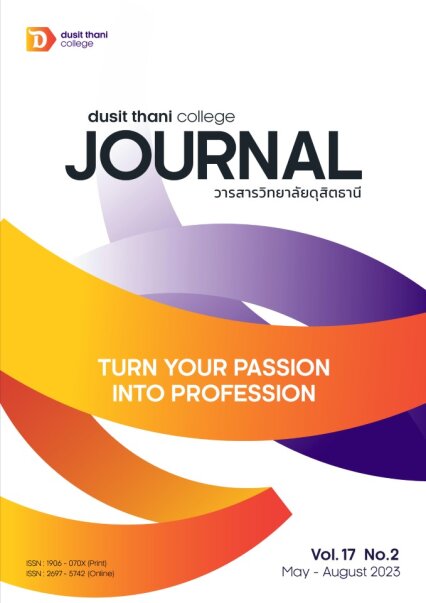Community Based Tourism by Creating Festival Experience: A Case Study of Sukhothai Loi Krathong and Candle Festival
Main Article Content
Abstract
The purpose of this article aims to study the patterns of experience in festival events and to present the ways to create experience by using Sukhothai Loi Krathong and Candle Festival. As one of the most well-known national festivals for tourists, it features a variety of interesting events and is held annually, which will help to promote attractive activities, can meet the needs of tourists in all dimensions, and is a memorable tourism experience, as well as a marketing tool that encourages the growth of tourism communities. In addition, this approach is also beneficial for organizers and entrepreneurs involved in prototyping or upgrading future festival by integrating community tourism knowledge with creating experiences through festival, which will lead to creative tourism concepts and joint integration.
Article Details

This work is licensed under a Creative Commons Attribution-NonCommercial-NoDerivatives 4.0 International License.
Article Screening Policy
- All research and academic articles to be published must be considered and screened by three peer reviews in the relevant field / article.
- All articles, texts, illustrations and tables published in the journal are the personal opinions of the authors. Editors don't always have to agree. And no responsibility whatsoever is the sole responsibility of the author.
- The articles to be published must never be published. Where did you first publish? And not in the consideration of other journals If the audit found that there has been a duplicate publication It is the sole responsibility of the author.
- Any article that the reader sees as being plagiarized or impersonated without reference. Or mislead the work of the author Please let the journal editor know it will be your greatest blessing.
References
Ayob, N., Wahid, N.A., and Omar, A. (2013). Mediating Effect of Visitors’ Event Experiences in Relation to Event Features and Post-Consumption Behaviors. Journal of Convention & Event Tourism. 14, 177–192.
Division of Information and Communication, Sukhothai Provincial Bureau. (2021). General Information. Retrieved September 14, 2021, from http://www.sukhothai.go.th.
Geus, S. D., Richards, G., and Toepoel, V. (2016). Conceptualisation and operationalisation of event and festival experiences: Creation of an event experience scale. Scandinavian journal of hospitality and tourism. 16(3), 274-296.
Ministry of Tourism and Sports. (2021). Tourist statistics. Retrieved September 14, 2021, from https://www.mots.go.th/more_news_new.php?cid=618.
Ministry of Culture. (2020). Flying, burning candles, playing lights, celebrate the World Heritage City. Printing Arts: Bangkok.
Niphat, P. and Narongkong, R. (2012). Nostalgia in Thai Tourism Industry. Journal of Ethics Studies of Klong and Salavin River. 3, 47-60.
Panida, N., Motipa, V. and Weerapon, V. (2021). Adaptive behavior in the tourism community of tourists in Sumutsongkram province. Innovation and Management Journal. (2).
Praman, T. (2018). The community's involvement in the mining of waterways to prepare a foundation plan for the restoration of the Lower Lagoon in Songkra Province. Kat Yai Journal. 16(2), 191-212.
Rudee, S. (2020). Marketing promotion strategies for community tourism. Social Journal Research & Development. 2(4), 51-61.
Sabaithip, M., Jiratchaya, C. and Panakrit, A. (2020). Enhancing the value chain of local tourism experience. Case studies, prototype area routes, Sukhothai Province. International Academic Tourism Magazine. 16(1), 57-80.
Tourism Authority of Thailand. (2016). Meeting Documents of The LINK Project, October 2016 in Bangkok.
Weerapon, T. (2016). Community Based Tourism: CBT For the development of the quality of life of the community in the forest land. Retrieved September 14, 2021, from www.dnp.go.th.


